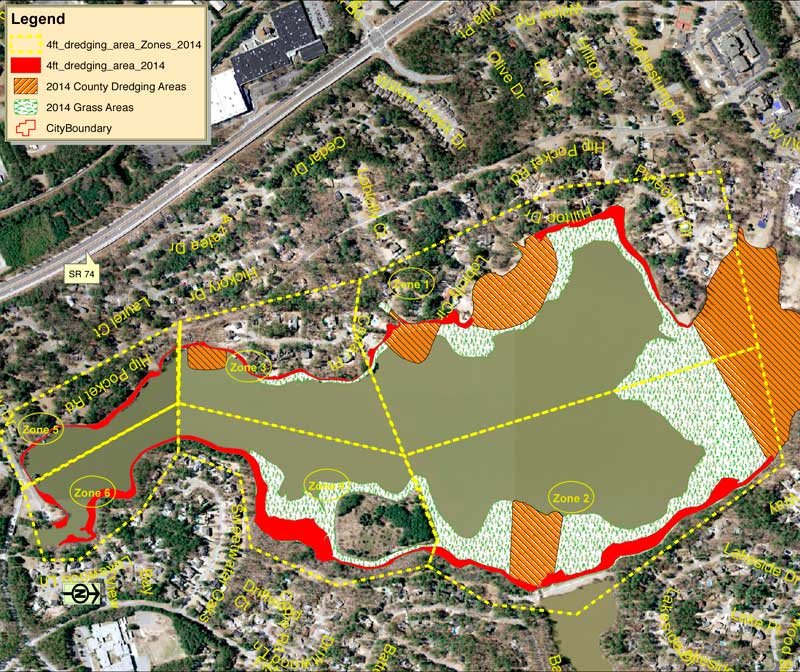The Peachtree City Council has decided that the city’s portion of the clean-up of Lake Peachtree will include the cost-saving measure of only removing vegetation from identified areas and will not include any dredging. Meantime, Fayette County is set to begin its previously-approved dredging project in other areas of the lake in the coming weeks.
The Peachtree City Council on Feb. 5 decided to ditch the dredging idea and instead to enter into negotiations to have vegetation removed in identified areas. Negotiations will soon begin with Massana Construction on an initial bid that would remove all identified vegetation for $235,000.
The council during the discussion, and at the initiation of Councilman Eric Imker, decided by consensus to only consider vegetation removal and to forego the more expensive dredging operation which would have included a number of areas around the shoreline.
Staff during the discussion noted that the prices provided by Massana Construction, the firm being used by the county for its dredging work, were negotiable.
“There is still some negotiation, so we’re not looking for a decision tonight,” said City Manager Jim Pennington.
Pennington said there are a number of unknowns with the project, such as the issue dealing with how to cut grass in a lake.
A study by Integrated Science and Engineering divided the lake and shoreline in to six zones.
Zone 1 — costs are $50,000 for vegetation removal. The large Zone 1 is located on the northwest area of the lake.
Zone 2 — costs are $120,000 for vegetation removal. Zone 2, also a large area, is located on the northeast area of the lake.
Zone 3 — costs are $6,500 for vegetation removal. Zone 3 is located in the west central lake area.
Zone 4 — costs are $58,500 for vegetation removal. Zone 4 is located in the east central area of the lake.
Zone 5 — there is no vegetation to remove in this zone. Zone 5 is located in southwest portion of the lake.
Zone 6 — there is no vegetation to remove in this zone. Zone 6 is located in the southeast lake area.
Not removing the vegetation and allowing it to die out when water levels return to normal could lead to other problems that could destabilize the lake, city staff said.
The cost for the vegetation removal from all six zones totaled $235,000 while the dredging of all six zones would have totaled an additional $602,500. With dredging no long under consideration, Pennington said the council could expect more information on the negotiations at the next council meeting.
The dredging work by the county, which includes the large area south of the Hwy. 54 bridge and in substantial portions of Zone 1 and Zone 2, is expected to get underway in late February or early March, said Pennington.
At the recommendation of Councilwoman Kim Learnard, city staff will also explore the idea of having the vegetation disposed of in a controlled burn to save on the overall cost of the project.
Pennington said the difference in the Massana bid and the others included variables that might account for the lower price. He said Massana will be hauling to a nearby location and will be selling the product.
The bids were those submitted to the county as an add-on for the city’s portion of the project that is separate from the contract with the county that will see a a large amount of dredging beginning in the area south of the Hwy. 54 bridge and in large areas on zones 1 and 2.
A bid of $1,449,410 from Massana Construction was approved by the Fayette County Commission on Jan. 22 for its dredging work. That work is expected to begin in the coming weeks, with completion in May.
Three firms out of the 18 contacted by the county submitted proposals. Massana’s bid was far lower than the other two: $3,755,087 from Brent Scarbrough & Co., and $3,679,920 from Waterfront Property Services (Gator Dredging).
County Administrator Steve Rapson explained the reason for the huge pricing disparity, saying that the largest components of the bid pertain to site work and removal of dirt as well as hauling. Massana already has a commercial application for the dirt, so the company is essentially splitting the cost between the county and the company that is buying the dirt.
“While we are approving a $1.5 million contract, this is actually closer to a $2.6-2.7 million project,” said Rapson.
With the bid approval completed, the next step is to go out and start putting down erosion control, which Rapson said should happen in early February.
The last dredging was a wet dredging and removed about 20,000 cubic yards, while this project will be dry. The higher amount of dirt this time, totaling 64,000 cubic yards, is “because it’s dry and you can see it instead of wondering where it is under the water,” Rapson said.
Below, a bigger view of the dredging, cutting map.







Leave a Comment
You must be logged in to post a comment.